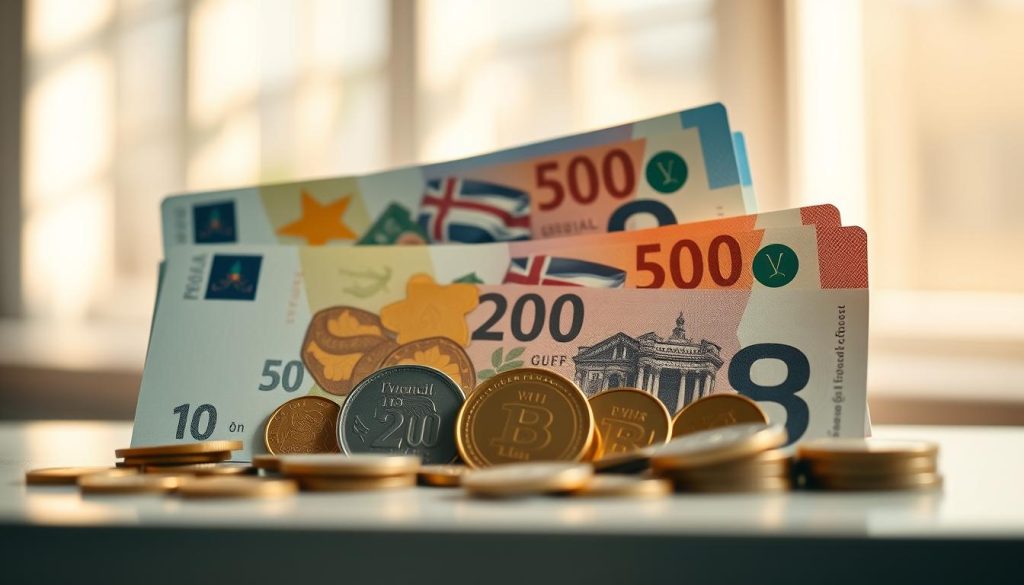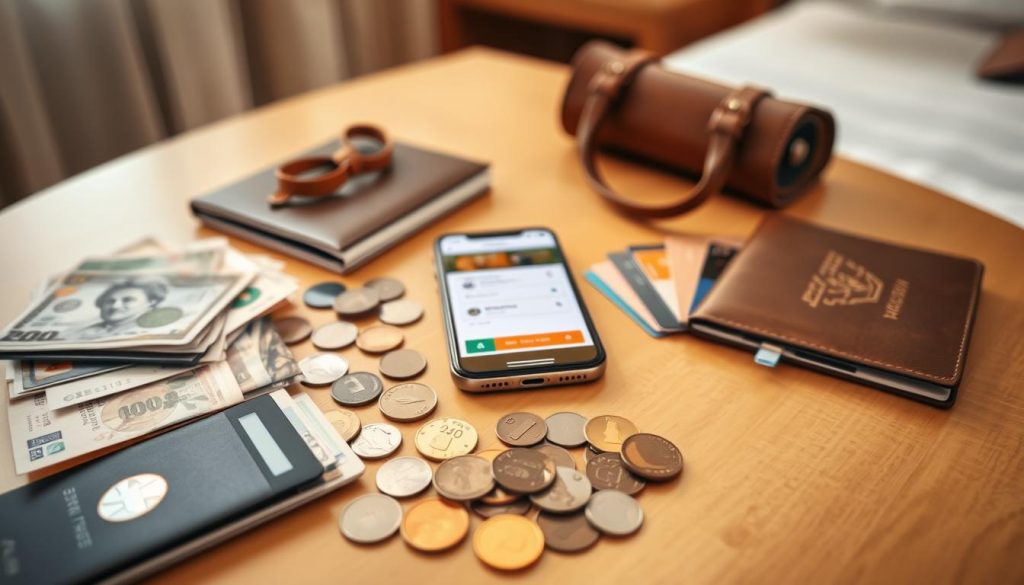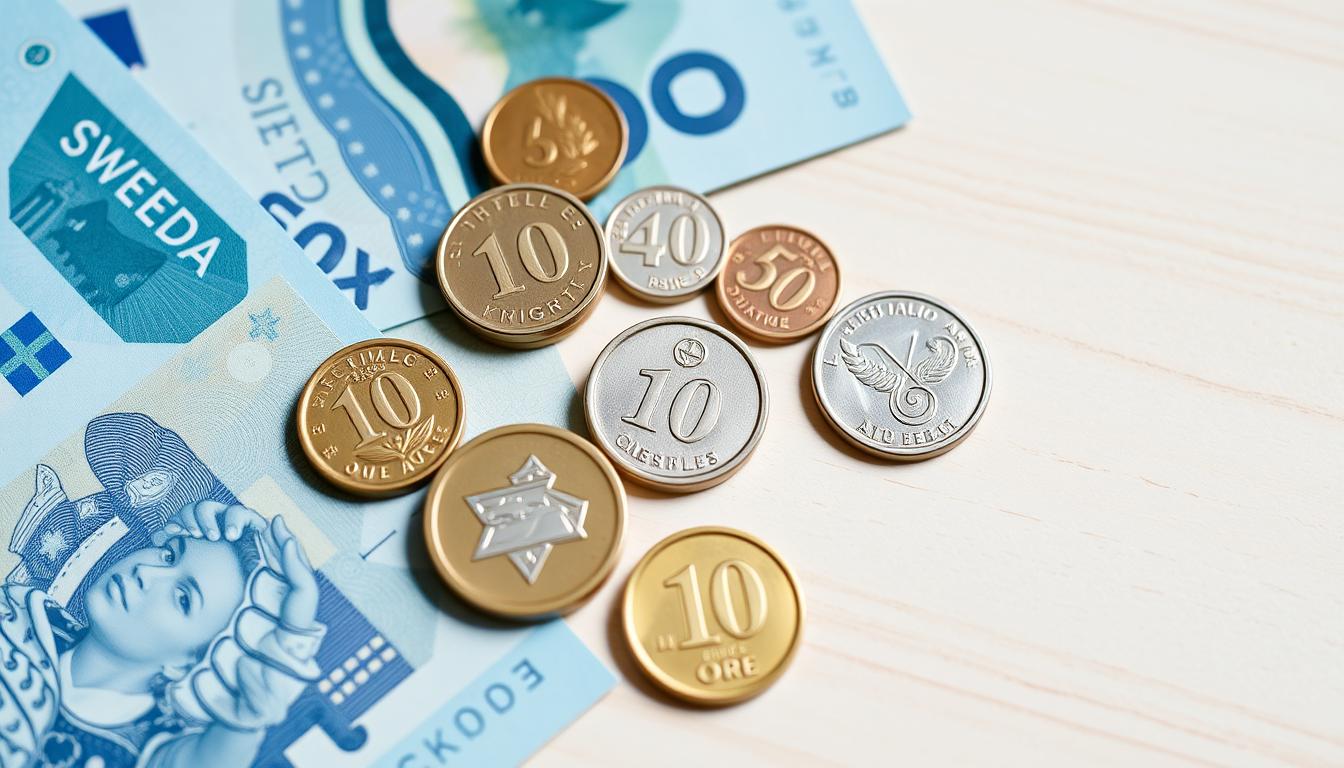✓ Accommodations✓ Flights✓ Rental Cars✓ Tours & Activities
Did you know that Stockholm is one of the most cash-free cities in the world? Many shops, restaurants, and hotels no longer accept cash, making it essential to understand how to manage your money effectively during your visit.
When planning your travel, knowing about the Swedish krona (SEK) is crucial. This currency is the backbone of all transactions, and understanding its value can save you from unnecessary fees and poor exchange rates.
This guide will walk you through everything you need to know about handling your finances in Sweden. From live exchange rate data to practical tips, you’ll learn how to make the most of your travel budget. Tools like Wise or Travelex can help you manage rates and fees efficiently, ensuring a smooth experience.
Understanding the Swedish Krona and Exchange Rates
Understanding the Swedish krona and its exchange rates can make your trip smoother. The SEK is the official currency and is widely used for everyday transactions. Knowing how it works can help you manage your budget effectively.

Overview of the Swedish Krona (SEK)
The Swedish krona, symbolized as SEK, is the backbone of financial transactions. It’s divided into 100 öre, though öre coins are no longer in circulation. You’ll find coins in denominations of 1, 2, 5, and 10 kronor, and banknotes in 20, 50, 100, 500, and 1,000 kronor.
In many places, especially major cities, cash is rarely used. Cards and digital payments are preferred, making SEK the primary currency for most transactions.
How the Mid-Market Exchange Rate Works
The mid-market exchange rate is the benchmark rate banks use for currency conversion. It’s the fairest rate you can get, as it’s not marked up for profit. For example, the USD/SEK rate is often used as a baseline for financial transactions.
Tourists often face higher rates due to markups by exchange services. Checking live rates online before and during your trip ensures you get the best deal. Tools like Wise or Travelex can help you compare rates and avoid hidden fees.
| Currency | Mid-Market Rate (Example) |
|---|---|
| USD/SEK | 10.50 |
| EUR/SEK | 11.20 |
| GBP/SEK | 13.00 |
By understanding the SEK and exchange rates, you can make informed decisions and save money during your travels. Always compare rates and use reliable tools to ensure a smooth financial experience.
Sweden: Ultimate Travelers Guide to Currencies & Payments
Currency plays a key role in shaping your travel budget and spending power. Understanding how it works ensures a smooth and stress-free experience. From exchange rates to payment methods, being informed helps you make the most of your trip.

Impact of Exchange Rates
Exchange rates directly affect how much you spend. For example, a favorable rate means your money goes further. Checking live rates before your trip helps you plan better and avoid unnecessary costs.
Using tools like Wise or Travelex can save you from hidden fees. These platforms offer competitive rates, ensuring you get the best value for your currency sweden conversions.
Managing Extra Fees
Proper currency management keeps extra fees at bay. For instance, using a card sweden with no foreign transaction fees can save you money. Carrying some cash for smaller purchases is also a smart move.
Planning ahead ensures you avoid poor exchange rates at airports or hotels. Instead, opt for local ATMs or trusted exchange services for better deals.
Benefits of Planning Payments
A Swedish-focused approach to payments ensures convenience and security. Most places accept credit and debit cards, making cashless transactions the norm. This reduces the need to carry large amounts of cash.
Being well-informed about payment options helps you avoid financial pitfalls. For example, knowing which cards are widely accepted ensures you’re never caught off guard.
By understanding the importance of currency sweden, you can enjoy a seamless and budget-friendly trip. Proper planning and informed decisions make all the difference.
Preparing Your Travel Money: Cash, Cards, and Digital Wallets
Managing your finances efficiently is key to a stress-free trip. Whether you’re exploring bustling cities or quaint towns, knowing how to handle your travel money ensures you’re always prepared. Let’s dive into the best ways to balance cash, cards, and digital wallets for a seamless experience.

Pros and Cons of Carrying Cash
Carrying cash has its advantages. It’s accepted almost everywhere, especially in smaller establishments or rural areas. Having some on hand is useful for small purchases or emergencies where card payments aren’t an option.
However, there are downsides. Carrying too much cash can be risky, and you might face challenges finding places to exchange it. In many locations, especially urban areas, digital payments are preferred, making cash less practical.
Leveraging Cards for Convenience and Security
Using a card is often the most convenient option. Most places accept debit cards and credit cards, and contactless payments are widely supported. This reduces the need to carry large amounts of cash and adds an extra layer of security.
Here’s why cards are a great choice:
- Security: Lost or stolen cards can be quickly blocked, unlike cash.
- Convenience: No need to worry about exchanging currency or carrying change.
- Tracking: Easily monitor your spending through bank statements.
For added benefits, consider a travel money card like Wise or Travelex. These cards lock in favorable exchange rates and often have lower fees compared to traditional bank cards.
Balancing cash and card usage ensures you’re ready for any situation. Carry a small amount of cash for emergencies, but rely on your card for most transactions. This approach keeps your finances secure and your trip hassle-free.
Tips for Exchanging Currency in Sweden
Getting the best deal on currency exchange can save you money and stress during your trip. Knowing where and how to exchange your funds ensures you maximize your spending power. Here’s how to navigate the process like a pro.
Best Practices at City Centers vs. Airports
Exchanging money at airports or hotels often comes with high fees and unfavorable rates. Instead, opt for ATMs or reputable exchange offices in city centers. These locations typically offer better rates and lower fees.
For example, ATMs in urban areas are widely available and often provide competitive rates. Always check for logos of international card networks like Visa or Mastercard to ensure compatibility.
Finding the Right Exchange Rates
Comparing mid-market rates is key to getting the best deal. Use online tools or apps to track live rates before exchanging your money. This helps you avoid unnecessary markups and ensures you’re getting a fair option.
Here’s a quick comparison of mid-market rates for popular currencies:
| Currency | Mid-Market Rate (Example) |
|---|---|
| USD/SEK | 10.50 |
| EUR/SEK | 11.20 |
| GBP/SEK | 13.00 |
Avoiding Hidden Fees and Markups
Hidden fees can quickly eat into your budget. Always ask about additional charges before completing a transaction. Some exchange services may advertise low rates but add extra fees later.
To avoid this, consider using a multi-currency account or a provider like Wise or Travelex. These platforms often lock in favorable rates and minimize hidden costs.
By following these tips, you can exchange your money wisely and keep your travel budget intact. Planning ahead and comparing options ensures a smooth and cost-effective experience.
Navigating Payment Options and Avoiding Extra Fees
Handling payments efficiently can make or break your travel experience. One common pitfall is Dynamic Currency Conversion (DCC), which can lead to higher fees and poor exchange rates. Understanding how to avoid these charges ensures your spending stays on track.

What is Dynamic Currency Conversion?
DCC occurs when a merchant offers to convert your payment into your home currency at the point of sale. While it might seem convenient, this service often comes with unfavorable rates and additional fees. For example, a $100 purchase could end up costing you $110 due to poor conversion rates.
Best Practices for Card Transactions
To avoid DCC, always opt to pay in the local currency, such as Swedish krona. Here’s how to ensure your debit or credit card transactions are processed correctly:
- Decline DCC offers: Politely refuse if the merchant suggests converting your payment.
- Check receipts: Verify that the transaction is in the local currency.
- Use reliable cards: Choose cards with no foreign transaction fees for better savings.
Pitfalls of Merchant Currency Conversion
Letting merchants handle currency conversion can lead to unnecessary costs. They often use their own exchange rates, which are less favorable than those offered by your bank. This way of processing payments can significantly increase your spending without you realizing it.
Strategies for Smart Payments
Here are some tips to safeguard your finances:
- Carry a multi-currency card: These cards lock in favorable rates and minimize fees.
- Use ATMs wisely: Withdraw local currency directly to avoid conversion charges.
- Monitor transactions: Keep an eye on your bank statements for any unexpected fees.
By understanding DCC and choosing the right payment methods, you can avoid extra fees and make the most of your travel budget. Always question conversion fees and seek the best way to manage your spending abroad.
Using ATMs and Local Banking Services
Navigating ATMs and banking services in Sweden is straightforward and convenient. Whether you’re in a bustling city or a quiet rural area, accessing cash and managing transactions is designed to be hassle-free. Here’s what you need to know to make the most of these services during your stay.
ATM Accessibility Across Sweden
Finding an atm in Sweden is easy, even in smaller towns. Major cities like Stockholm and Gothenburg have a high concentration of ATMs, often labeled as Bankomats. These machines are usually blue and accept international cards from networks like Visa and Mastercard.
In rural areas, ATMs might be less frequent, but they are still available at local bank branches or shopping centers. Always look for logos of international card networks to ensure compatibility.
Managing International Bank Fees
Using your card abroad can come with extra fees. To minimize these costs, notify your bank about your travel plans. This prevents your card from being flagged for suspicious activity.
Here are some tips to reduce fees:
- Choose local currency: When prompted, select Swedish krona to avoid Dynamic Currency Conversion (DCC) fees.
- Use fee-free ATMs: Look for Bankomat ATMs, which don’t charge withdrawal fees.
- Withdraw larger amounts: Minimize transaction fees by withdrawing more cash less frequently.
Local banks like SEB, Swedbank, and Nordea are reliable options for international visitors. They offer secure transactions and often have English-language services to assist tourists.
By understanding how to use ATMs and manage bank fees, you can access cash securely and save money during your trip. Sweden’s cashless society still provides reliable options for those who prefer physical currency.
Maximizing the Benefits of Multi-Currency Travel Cards
Multi-currency travel cards are a game-changer for international trips. They allow you to manage your finances efficiently, lock in exchange rates, and avoid unnecessary fees. Whether you’re exploring cities or rural areas, these cards simplify transactions in the official currency of your destination.
Why Choose a Multi-Currency Travel Card?
Using a travel card offers several advantages. First, it lets you lock in exchange rates before your trip, protecting you from fluctuating rates. Second, it reduces the need for carrying large amounts of cash, making your travels safer. Finally, it minimizes foreign transaction fees, saving you money in the long run.
Here’s how these cards work:
- Load multiple currencies: Store funds in different currencies for seamless spending.
- Lock in rates: Convert your money at favorable rates before you travel.
- Avoid hidden fees: Use your card without worrying about extra charges.
Comparing Providers Like Wise and Travelex
When choosing a multi-currency card, it’s important to compare providers. Two popular options are Wise and Travelex. Both offer competitive rates and low fees, but they have distinct features.
Here’s a quick comparison:
| Provider | Key Features | Fees |
|---|---|---|
| Wise | Supports 50+ currencies, mid-market rates | Low conversion fees, no monthly fees |
| Travelex | Prepaid card, supports 10+ currencies | No foreign transaction fees, ATM fees apply |
Wise is ideal for frequent travelers who need access to multiple currencies. Travelex, on the other hand, is great for those who prefer a prepaid option with straightforward pricing.
How to Choose the Best Travel Card
Selecting the right travel card depends on your needs. Consider the following factors:
- Supported currencies: Ensure the card supports the official currency of your destination.
- Fee structure: Look for cards with low or no foreign transaction fees.
- Ease of use: Choose a card with a user-friendly app or online platform.
“A good travel card is like a financial safety net—it keeps your money secure and your trip stress-free.”
By using a multi-currency card, you can simplify your transactions and focus on enjoying your trip. Whether you’re a frequent traveler or planning a one-time adventure, these cards are a smart way to manage your finances abroad.
Additional Sweden Travel Tips for a Smooth Experience
Exploring a new country is always exciting, but knowing a few local tips can make your experience even better. Beyond managing your finances, understanding the culture and practicalities of daily life can enhance your trip. Here’s how to make the most of your time abroad.
Local Etiquette and Language
When visiting, it’s a good idea to learn a few basic phrases in the local language. Simple greetings like “Hej” (Hello) and “Tack” (Thank you) go a long way in showing respect. Swedes value personal space and punctuality, so be mindful of these cultural norms.
Tipping is not mandatory, but rounding up the bill is appreciated. For example, if your meal costs 480 kronor, you might round it up to 500 kronor. This is a polite way spend your money while acknowledging good service.
Safety and Public Transport
Safety is rarely a concern, but it’s always smart to stay aware of your surroundings. Public transport is efficient and widely used. Consider purchasing a travel card for unlimited rides during your stay. This saves time and money compared to buying individual tickets.
If you’re arriving by plane, plan your airport transfer in advance. Many hotels offer shuttle services, or you can use reliable apps to book a ride. This ensures a smooth start to your trip.
Choosing Accommodations
Selecting the right place to stay is key to a comfortable trip. Whether you prefer a luxury hotel or a budget-friendly option, book early to secure the best rates. Staying in central locations saves time and makes it easier to explore.
For a unique idea, consider boutique hotels or Airbnb stays. These often provide a more authentic experience and allow you to immerse yourself in the local culture.
Creative Ways to Spend Your Time
Make the most of your trip by trying local activities. Visit museums, explore nature trails, or attend cultural events. These experiences offer a great way spend your time while learning about the country’s heritage.
Planning your days efficiently ensures you don’t miss out on must-see attractions. Allocate time for both popular spots and hidden gems to create a balanced itinerary.
By following these tips, you’ll not only manage your trip smoothly but also create lasting memories. Embrace the local culture, stay organized, and enjoy every moment of your adventure.
Conclusion
Planning your finances ahead ensures a seamless experience in a cashless society. Understanding the official currency and payment methods is essential for a hassle-free trip. This guide has highlighted key strategies to manage your money effectively, from using cards to avoiding unnecessary fees.
By evaluating your payment options, you’ll find the best approach for your needs. With the right tools and knowledge, you ’ll need minimal stress when handling financial matters. Whether you’re exploring cities or rural areas, being informed makes all the difference.
Take these insights home and confidently embark on your adventure. Navigating one of the most advanced, cashless countries in the world is easier than you think. With preparation and the right mindset, you’re ready to enjoy every moment of your journey.
The above is subject to change.
Check back often to TRAVEL.COM for the latest travel tips and deals.






